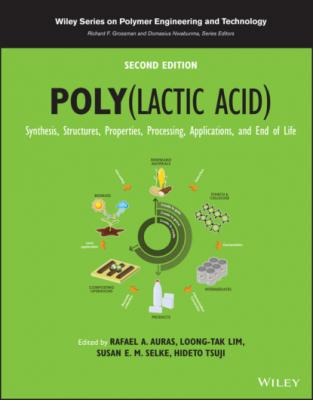Poly(lactic acid). Группа авторов
Чтение книги онлайн.
Читать онлайн книгу Poly(lactic acid) - Группа авторов страница 80
 model from the α (α′) form to the β form. The set of arrays A, B and A slip along the 110 planes.
model from the α (α′) form to the β form. The set of arrays A, B and A slip along the 110 planes.
Source: Modified from the reference [20]. Reproduced from Wang et al., Macromolecules 2017, 44, 3285–3300.
(c) The change of the X‐ray coherent domain size in the transition process from the α to δ to β forms.
PLLA α form
Elastic constants matrix,
Compliance tensors matrix,
PLLA δ form
PLLA β form
The calculated Young’s moduli along the c‐axis (E c = 1/s 33) are compared among the α, δ, and β forms, as shown below:
α form: E c = 14.7 GPa [66] (X‐ray observed 13.76 GPa [66, 73])
δ form: E c = 12.5 GPa [66] (X‐ray observed 12.58 GPa [66])
β form: E c = 15.4 GPa [20]
The experimental evaluation of the Young’s modulus of the crystal lattice along the chain axis, which is often called the crystallite modulus, was performed using the X‐ray diffraction method [67], where the crystalline strain along the chain axis was measured under constant tensile stresses by assuming the stress working on the crystalline region was equal to the stress of the bulk sample (the assumption of homogeneous stress distribution) [67, 72]. The agreement between the observed and calculated values is relatively good. The crystallite modulus changes depending on the conformational regularity of the PLLA chain: the mesophase (6.7 GPa) < the δ form (12.9 GPa) < the α form (14.7 GPa) < the β form (15.4 GPa). For reference, the X‐ray‐measured crystallite modulus of PLLA/PDLA stereocomplex is 20 GPa, in which the PLLA or PDLA chain takes a 3/1 helical conformation similar to that of the β form [73].
The crystallite modulus changes depending on the mechanical deformation mechanism of the molecular chain, i.e., the degree of change in the internal coordinates (bond lengths, bond angles, and torsional angles) induced by the external force [67–71]. For example, a planar‐zigzag polyethylene chain is deformed by the stretching of C─C bonds and the deformation of C─C─C bond angles, resulting in a Young’s modulus of 300 GPa [67, 69]. The deformation of a helical chain is induced mainly by the change of the torsional angles, giving 1–2 order lower modulus. The deformation of PLLA helical chains also occurs through the torsional angles around the skeletal C─C and C─O bonds. The disordered chain is more easily deformed due to the easier torsional angle changes. In addition, the methyl groups jutting from the main chain significantly increase the effective cross‐sectional area of the chain. The synergetic effect of these two factors results in the above‐mentioned order of the modulus among the meso, δ, α, and β forms. The crystallite modulus of PLLA chain (in the order of 15 GPa) is lower than those of isotactic polypropylene (34 GPa) and polyoxymethylene (70 GPa) [66, 70], which can be understood from the difference of the chain conformation; the latter two polymers have a tighter and more rigid helical conformation than the PLA chain.
The anisotropic mechanical property is also important. The Young’s modulus in the plane perpendicular to the chain axis is governed mainly by the H…H interatomic interactions